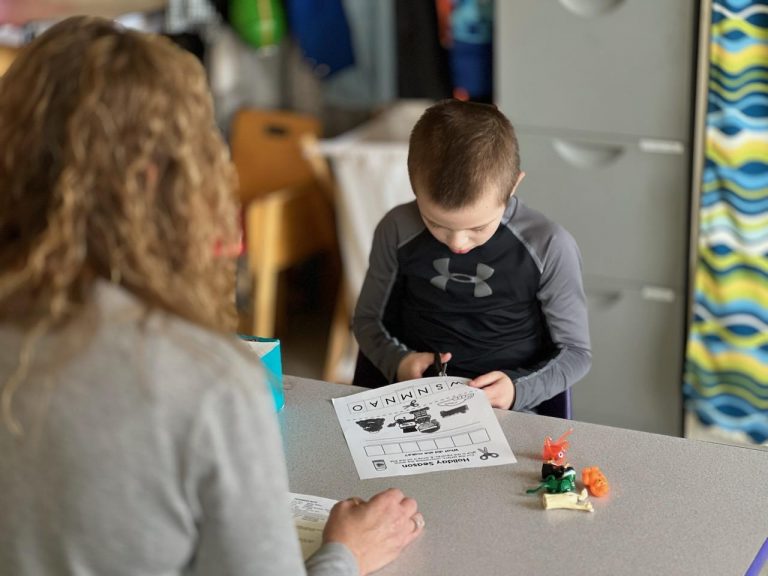
As a parent, you want the best for your child, especially when it comes to helping them communicate effectively. If your child is attending private speech therapy, you may be wondering what happens during these sessions, what goals are being worked on, and how you can stay connected to the therapy process. This guide is here to help you understand what happens in speech therapy, how therapists work toward your child’s goals, and ways to feel more engaged and connected along the way.
What Happens in a Speech Therapy Session?
Every child is unique, and so is every speech therapy session. Therapists tailor each session to meet your child’s needs, strengths, and interests. Here’s a breakdown of what typically happens:
- Building Connection: Many sessions begin with a warm-up or “hello” activity to make your child feel comfortable. This could be a fun game, a short conversation, or a few minutes spent building trust and rapport. Building a connection helps your child feel safe and ready to participate.
- Practicing Communication Skills: During each session, the therapist focuses on specific skills that your child needs to work on. For example, if your child is working on saying sounds more clearly, they’ll practice sounds through words and sentences. If your child is learning to express needs or answer questions, the therapist might use games, books, or toys to encourage speaking and interaction.
- Engaging Activities: Speech therapy sessions are often playful, using games, toys, and activities. This playful approach keeps therapy fun, which helps children stay engaged and motivated to learn. It also makes speech practice feel more like a game rather than hard work.
- Reinforcing New Skills: Therapists often end sessions by reviewing what was practiced. This might be a quick summary of what your child did well or a fun activity to show how much progress was made. The therapist may also discuss these highlights with your child, reinforcing the skills practiced that day.
Understanding Therapy Goals
Speech therapists work with each family to set therapy goals for their child. These goals are often based on evaluations and conversations with you, the parent, about your hopes for your child’s communication progress.
- Short-Term vs. Long-Term Goals: In therapy, we use both short-term and long-term goals. Long-term goals are big-picture aims, like “improving speech clarity” or “increasing vocabulary.” Short-term goals are specific skills or steps that lead to those big goals. For example, if the long-term goal is clear speech, a short-term goal could be practicing specific sounds like “s” or “r.”
- Tracking Progress: Therapists measure progress toward goals in many ways. They might keep notes about each session or use checklists to see how often a skill is being used correctly. Over time, you’ll see these skills add up and notice more changes in your child’s communication.
- Updating Goals as Your Child Grows: As your child achieves each short-term goal, the therapist will update and adjust their plan. This ensures that therapy is always working toward the next step in your child’s journey. These adjustments help keep therapy relevant and challenging in a positive way.
Clear Communication: How Your Therapist Keeps You Informed
It’s natural to want to know what your child is working on and how they’re doing in therapy. Speech therapists aim to keep you in the loop by:
- Sharing Session Summaries: Many therapists provide brief summaries after each session. This could be a quick note, a short conversation, or a text message. These summaries might cover what skills were practiced, what games or activities your child enjoyed, and what progress was made.
- Parent-Teacher Meetings: Some clinics offer regular meetings to discuss your child’s progress and answer any questions you may have. These meetings allow the therapist to go into more detail about your child’s strengths, areas they’re working on, and ways you can support them at home.
- Home Practice Tips: Therapists might suggest simple activities or phrases for you to practice with your child at home. Practicing at home can reinforce skills and make therapy progress happen faster. It also helps you stay connected to what your child is learning.
- Clear Goals: Don’t be afraid to ask your therapist about your child’s specific goals. They can explain what your child is working toward, how they’re measuring success, and what you can look for at home to see progress.
Overcoming Feeling Disconnected from Therapy
Feeling “out of the loop” with your child’s therapy can be frustrating. But there are ways to feel more connected:
- Ask for Involvement: Some parents find it helpful to join the first few minutes of a session or observe from a nearby room. Many clinics have observation windows or video options, allowing you to watch without interrupting. Watching a few sessions can give you a better idea of how therapy looks and how your child interacts with their therapist.
- Weekly Check-Ins: If daily summaries aren’t available, ask if you can check in with the therapist once a week or every other week. These check-ins can help answer questions you have about your child’s progress and give you peace of mind.
- Request Resources for Home Practice: Therapists often have fun, practical suggestions for supporting speech goals at home. Practicing together can help you feel more engaged, plus it’s a great bonding activity that supports your child’s progress.
- Celebrate Small Wins: Progress in speech therapy happens little by little. Take time to celebrate every “win,” whether it’s a new sound, a new word, or better understanding of a question. Small steps add up to big results, and celebrating together reinforces your child’s hard work and builds confidence.
Supporting Your Child’s Therapy Outside of Sessions
Children who practice skills outside of therapy tend to progress faster and feel more confident. Here are some simple ways to support your child at home:
- Use Everyday Moments: Incorporate speech practice into daily activities. For example, during meals, ask your child to name foods, describe what they’re eating, or tell you a story about their day. At the grocery store, they can help name items or describe what you’re buying.
- Practice in Play: Playing together can be a natural way to work on communication. Games that encourage taking turns, naming colors, or asking questions help reinforce language skills. Even pretend play, like playing “restaurant” or “doctor,” can involve new vocabulary and phrases.
- Be Patient and Encouraging: Speech therapy is a journey, and it can take time for changes to show. Celebrate each new skill and remind your child that they’re doing a great job. Avoid over-correcting their speech; instead, gently model correct sounds or sentences.
The Importance of Parent-Therapist Communication
Good communication between parents and therapists helps keep everyone on the same page. Here are some tips for building a strong partnership with your child’s therapist:
- Share Observations: If you notice something new or challenging at home, let your therapist know. Whether it’s a new word, a difficult sound, or a frustration your child is having, sharing these observations helps the therapist adjust therapy to meet your child’s needs.
- Ask Questions: Therapists are here to support you and your child. Never hesitate to ask questions if something feels unclear. Therapists are happy to explain methods, goals, and ways to support your child at home.
- Provide Feedback: If there’s something you’d like more of, such as tips for home practice or updates on progress, let your therapist know. Good therapists appreciate feedback and want you to feel included in the therapy process.
What to Expect as Your Child Progresses
Speech therapy takes time, and it’s normal to wonder about the pace of your child’s progress. Here’s what to keep in mind:
- Patience is Key: Building communication skills doesn’t happen overnight. Children often need time and practice to learn new sounds or words. Trust the process and know that progress, even if it’s slow, is still progress.
- Celebrate Small Milestones: Every new sound, word, or ability to follow instructions is a reason to celebrate! These small milestones are building blocks toward your child’s long-term communication goals.
- Expect Some Setbacks: Sometimes, children may feel tired, frustrated, or even lose interest in practicing. This is normal, and setbacks can be part of the process. Keep the atmosphere positive and supportive, and know that your therapist can help you handle these moments.
Conclusion
Supporting your child’s communication journey can be incredibly rewarding, especially as you see them make strides toward their goals. Understanding what happens during speech therapy sessions, knowing the goals your therapist is working toward, and staying connected throughout the process can make a huge difference for both you and your child. Remember, therapists are your partners in this journey, and they are here to support your family every step of the way. Together, with patience, practice, and a lot of encouragement, you’re helping your child build the skills they need to express themselves with confidence and joy.









